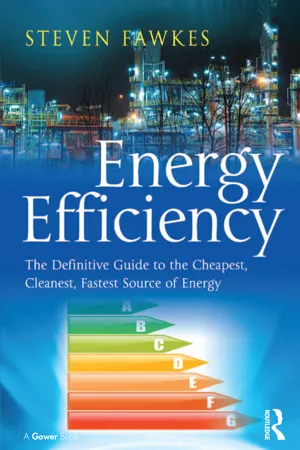Energy Efficiency
Energy efficiency refers to using less energy to perform the same task or function, thereby reducing energy waste and costs. It involves optimizing the use of energy through efficient technologies and practices, such as insulation, energy-efficient appliances, and renewable energy sources. Improving energy efficiency is crucial for reducing environmental impact and promoting sustainable development.
6 Key excerpts on "Energy Efficiency"
- eBook - ePub
Energy Efficiency
The Definitive Guide to the Cheapest, Cleanest, Fastest Source of Energy
- Steven Fawkes(Author)
- 2016(Publication Date)
- Routledge(Publisher)
...8 Technologies for Energy Efficiency Civilization advances by extending the number of important operations which we can perform without thinking of them. Alfred North Whitehead, Mathematician and Philosopher Any sufficiently advanced technology is indistinguishable from magic. Arthur C. Clarke, Science fiction writer and Futurist Any new technology has to go through a 25 year adoption cycle. Marc Andreesen, Entrepreneur, Software engineer and Investor Prediction is very difficult, especially about the future. Niels Bohr, Physicist Introduction High energy prices coupled with stronger environmental and sustainability drivers have led to a surge of interest in applying existing Energy Efficiency technologies and an increase in investment in developing new technologies and techniques to improve efficiency. This field is now so wide that it is impossible to fully survey all of the Energy Efficiency technologies now in use or under development. Therefore, this chapter only looks at a small sample of technologies with large potentials. As we have seen in Chapter 3, the Energy Efficiency gap is the gap that can be filled by the application of existing, economic technologies. The rate of technological change in all areas of technology is astounding and this also applies to Energy Efficiency technologies. Therefore, in this chapter we focus more on emerging technologies that have been commercialized recently or are in the process of commercialization. Many, many more examples, as well as detailed technical discussions of different technologies and their applications, can be found in the multitude of more specialized books and internet resources. As well as pure demand-side technologies we have also included some distributed-generation technologies, namely small scale Combined Heat and Power (CHP or cogeneration) and Waste Heat to Power (WHP)...
- eBook - ePub
- Kornelis Blok, Evert Nieuwlaar(Authors)
- 2016(Publication Date)
- Routledge(Publisher)
...10 Energy Efficiency The concept ‘Energy Efficiency’ was introduced in Chapter 3. This concept is not as straightforward as it seems, and there are various complications to measuring Energy Efficiency, which will be treated in this chapter. First, this chapter will discuss the meaning of Energy Efficiency (10.1) and Energy Efficiency improvement (10.2). Subsequently, we will provide a taxonomy of Energy Efficiency improvement measures (10.3). We will discuss how technical Energy Efficiency is measured (10.4), discuss an aggregated measure for Energy Efficiency (10.5), and monetary indicators (10.6). We will pay attention to the so-called rebound effect (10.7) and finally we will discuss new business approaches around Energy Efficiency (10.8). 10.1 What is Energy Efficiency? Striving for efficiency is trying to obtain a certain result with a minimum of input. As energy is used to fulfil human needs, one may define the Energy Efficiency of an activity as the degree to which given human needs are fulfilled with a minimum amount of energy. More practically, one may consider the efficiency of a piece of equipment. This equipment produces some uniform, measurable output P, and uses an amount of energy E. Then, the Energy Efficiency η of the equipment can be defined as: For many energy conversion processes, like power plants and boilers, the useful output is in the form of energy, and the Energy Efficiency is the usual measure, becoming a dimensionless quantity, often expressed as a percentage. For instance, we say that a power plant has an Energy Efficiency of 40 per cent. However, for many end-use applications energy output is often not relevant. For instance, a car produces heat, but that is not very interesting. A good indicator for the useful output of a car is the distance travelled...
- eBook - ePub
- Raymond S. Nickerson(Author)
- 2002(Publication Date)
- Psychology Press(Publisher)
...Realization of such a goal requires a better understanding than we have of the difference between fundamental human needs and desires on the one hand and wants that have been manufactured and sold to consumers for no other reason than to create a market for products of dubious worth. It also requires a better understanding of how technology relates, at a deep level, to fundamental human needs and quality of life. INCREASING THE EFFICIENCY OF ENERGY USE Arguably, technology’s most spectacular successes have involved the development of practical ways of producing energy from matter, changing energy from one form to another, and applying the results to human ends. There can be no doubt that we have benefited greatly from these successes. As Ward and Dubos (1972) put it: It is difficult to overestimate the degree to which the use of energy and the manipulation of materials has reduced the crushing burdens of physical work, lessened the concentration of human effort on food production, freed men for other pursuits, and extended to millions a wealth and opportunity formerly enjoyed by the smallest elite. (p. 16) Yet the environmental effects of energy production and use are a legitimate concern and motivate the search for greater efficiencies in this regard. Increasing the efficiency with which energy is used can be environmentally beneficial in at least two ways: It can increase the yield of goods and services for a given expenditure of natural resources, and it can decrease the magnitude of detrimental environmental effects resulting from a given amount of energy produced or used. It also has the economic benefit of decreasing the cost of energy on a unit basis. Conversely, avoidable inefficiencies in the use of energy are costly in many ways...
- eBook - ePub
- Brian Dawson, Matt Spannagle(Authors)
- 2008(Publication Date)
- Routledge(Publisher)
...Energy Efficiency Energy Efficiency relates the output of an energy service (heating, lighting, cooling, transport) or a transformation system (electricity) to its energy input. For example, a compact fluorescent light (CFL) is more energy efficient than a standard incandescent bulb as it produces the same amount of light (the energy service) but consumes one-quarter of the energy: more useful energy output is obtained per unit of energy input. It is useful to distinguish between Energy Efficiency, which refers to the amount of energy required to meet a specific demand for energy services (such as lighting or heating), and energy conservation, which refers to a reduction in energy service demand (such as turning off a light when not needed or turning down the thermostat in winter). Energy Efficiency measures aim to obtain the same energy services from less primary energy input. In contrast, energy conservation aims to reduce the demand for energy services. Both have a major role to play in reducing energy consumption and, in turn, greenhouse gas emissions. The global economy is grossly inefficient in the way it uses energy. Large amounts of energy are wasted in energy transformation, powering inefficient appliances (even when in the off-stand-by mode), poorly designed buildings and production processes, maintaining comfortable indoor temperatures in buildings, or transporting people and goods from one location to another. This comes at a huge economic cost to businesses and households. Total preventable energy waste (that which can be cost-effectively avoided) costs the global economy more than US$ 1 trillion per year. 1 Energy Efficiency is worth doing regardless of the greenhouse gas emission reduction benefits. Energy Efficiency is the most socially beneficial and least cost means of achieving large-scale carbon dioxide (CO 2) emission reductions in the medium term (at least out to 2030). The opportunities for saving energy and money are enormous...
- eBook - ePub
- Benjamin K. Sovacool, Benjamin K. Sovacool(Authors)
- 2010(Publication Date)
- Routledge(Publisher)
...While efficiency measures, such as end-use efficiency and system efficiency, do not provide an energy policy that achieves the goal of minimal environmental impact (in order to promote energy security), such measures do provide a partial solution. Further renewable energy development, such as from wind, solar or geothermal resources, can replace traditional generation. Just as the use of metrics can reveal the risks posed by environmental concerns, metrics may also demonstrate the success of mitigation measures. Energy Efficiency can curb GHG emissions, and as the IPCC noted in its 2007 report, Energy Efficiency can be the most effective and economic response to the threat of climate change in the immediate future. The idea behind Energy Efficiency is to use less energy, but also avoid disrupting the way people live or interfering with the quality of products they consume. In fact, according to one leading private consulting group, “Energy Efficiency offers a vast, low-cost energy resource for the U.S. economy … [and] [s]uch a program is estimated to reduce end-use energy consumption in 2020 by 9.1 quadrillion BTUs, roughly 23 percent of projected demand, potentially abating up to 1.1 gigatons of greenhouse gasses annually.” 47 End-use Energy Efficiency achieves these gains by making products more efficient. For example, minimum performance standards can be set for domestic and commercial products, such as washing machines, building materials, and automobiles. 48 Radiant heating systems that are embedded within workshop floors are a more efficient use of energy than warming air and then circulating it. 49 Another popular example is the fact that compact fluorescent lamps use 75 to 80 percent less electricity than incandescent bulbs. 50 In both of these cases—heat and light—the same result is delivered to the consumer, but in a way that uses less energy...
- eBook - ePub
- Mohan Munasinghe(Author)
- 2019(Publication Date)
- Routledge(Publisher)
...2 Energy Efficiency and Conservation The Basic Economic Criterion for Conservation This chapter will focus upon the relevance of energy conservation, its uses in the technical and economic context, and the means for effective implementation of conservation measures. In a period of rising energy prices and shortages the goals of energy conservation seem to be intuitively acceptable, even laudable. Energy conservation is an important element of demand management and, therefore, a valuable tool for achieving most of the objectives of integrated national energy planning discussed earlier. The pursuit of energy conservation as a goal raises the issue of whether the reduction of energy consumption is always socially beneficial or desirable. Common sense indicates that while "wasteful" energy use should be discouraged, there is a limit beyond which conservation measures could cause more harm than good. In order to define desirable conservation levels more precisely, we start from the premise that the principle objective of a national economy is to maximize the collective welfare of its citizens. If aggregate consumption or production (e.g., gross domestic product or GDP) is taken as a proxy for national welfare, then welfare maximization implies that scarce resources such as energy, capital, labor, and land should be used as efficiently as possible to maximize output. 1 This suggests that the concepts of both economic and technical efficiency are important in determining desirable conservation policies. Conservation measures for either cutting back use or for energy substitution usually lead to three types of economically significant consequences. First, the reduction or substitution in energy use gives rise to a net cost saving benefit, B. Second, the implementation of the conservation measure may involve additional costs, e.g., hardware costs, C 1...





